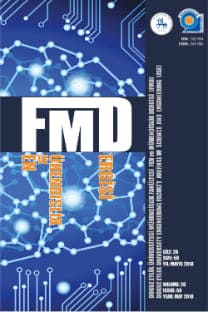Sayısal Görüntü İşleme ile Titreşim Yer Değiştirmelerinin Ölçümü ve Modal Parametre Tayini
omputer Vision Based Vibrational Displacement Measurement and Modal Identification
___
- Mukhopadhyay, S.C., ed. 2011. New Developments in sensing technology for structural health monitoring, Lecture Notes in Electrical Engineering, Springer, Berlin.
- Brincker R, Andersen P, Jacobsen NJ., 2007. Automated frequency domain decomposition for operational modal analysis. Proceedings of IMAC-XXIV: A Conference and Exposition on Structural Dynamics. Society for Experimental Mechanics, Florida, USA.
- Van Overschee P., De Moor B. 1996. Subspace identification for linear systems: Theory - Implementation - Applications. Kluwer Academic Publishers, Dordrecht, The Netherlands
- Rainieri, C. ve Fabbrocino,G. 2014. Operational Modal Analysis of Civil Engineering Structures An Introduction and Guide for Applications, Springer, Berlin.
- Catbas, N.F., Correa,K.T ve Aktan,A.E. 2013. Structural Identification of Constructed Systems Approaches, Methods, and Technologies for Effective Practice of St-Id, American Society of Civil Engineers, ASCE,USA.
- Feng, M.Q., Fukuda, Y., Feng, D. and Mizuta, M. 2015 Nontarget Vision Sensor for Remote Measurement of Bridge Dynamic Response, Journal of Bridge Engineering, Cilt. 20(12), s. 1-11.
- Khuc, T. and Catbas, F.N. 2017. Completely contactless structural health monitoring of real-life structures using cameras and computer vision, Structural Control and Health Monitoring,Cilt. 24(1), s. e1852, DOI: 10.1002/stc.1852
- Feng, D., Feng, M. Q., Ozer E. ve Fukuda Y. 2015. A Vision-Based Sensor for Noncontact Structural Displacement Measurement, Sensors, Cilt. 15, s. 16557-16575. doi:10.3390/s150716557
- Dworakowski Z., Kohut, P., Gallina, A., Holak K. ve Uhl, T. (2016) Vision-based algorithms for damage detection and localization in structural health monitoring,Structural Control and Health Monitoring, Cilt. 23, s. 35– 50. 10.1002/stc.1755
- Yoon, H., Elanwar, H., Choi, H., Fard,M.G., Spencer, B.F. 2016. Target-free approach for visionbased structural system identification using consumergrade cameras, Structural Control and Health Monitoring, Cilt. 23, s. 1405–1416. DOI: 10.1002/stc.1850
- Oh, B.K., Hwang, J.W., Kim,Y., Cho,T., Park, H.S. 2015. Visionbased system identification technique for building structures using a motion capture system, Journal of Sound and Vibration, Cilt. 356, s. 72–85. http://dx.doi.org/10.1016/j.jsv.20 15.07.011
- Feng, D., Feng, M.Q. 2017. Experimental validation of costeffective vision-based structural health monitoring, Mechanical Systems and Signal Processing, Cilt. 88, s. 199–211. http://dx.doi.org/10.1016/j.ymssp .2016.11.021
- Kohut, P., Holak,K., Uhl,T., Ortyl, L., Owerko,T., Kuras, P. And Kocierz, R. 2013. Monitoring of a civil structure’s state based on noncontact measurements, Structural Health Monitoring Cilt. 12(5-6), s. 411–429. DOI: 10.1177/1475921713487397
- Kim, S.W., Kim N.S. 2013. Dynamic characteristics of suspension bridge hanger cables using digital image processing, NDT&E International, Cilt. 59, s. 25–33. http://dx.doi.org/10.1016/j.ndtein t.2013.05.002
- Ye, X.W., Dong, C. Z., Liu, T. 2016. A Review of Machine Vision-Based Structural Health Monitoring: Methodologies and Applications, Journal of Sensors, 7103039, 10 pages.http://dx.doi.org/10.1155/2 016/7103039
- Shi, J., Tomasi.C. 1994. Good features to track. IEEE Conference on Computer Vision and Pattern Recognition (CVPR'94), 593 – 600.
- Fredriksson, K., Ukkonen, E. 2001 Faster template matching without FFT. In: Proc. IEEE Intl. Conf. on Image Processing (ICIP). Volume 1, 678–681.
- Barron, J.L., Fleet, D.J., Beauchemin, S.S. 1994. Performance of optical flow techniques. International Journal of Computer Vision, Cilt. 12, s. 4377. DOI: 10.1007/BF01420984
- Ullah,F. Kaneko,S 2004. Using orientation codes for rotationinvariant template matching, Pattern Recognition Cilt.37, s. 201 – 209 doi:10.1016/S00313203(03)00184-5
- Ji,Y.F., Chang,C.C. 2008. Nontarget image-based technique for small cable vibration measurement, Journal of Bridge Engineering Cilt.13, s. 34 - 42 doi:10.1061/_ASCE_10840702_2008_ 13:1_34_
- http://avesis.yildiz.edu.tr/serhate/ dokumanlar
- Ewnis,D.J. 2000. Modal Testing: theory, practice and application, 2nd edition, Research Studies Press, England
- ISSN: 1302-9304
- Yayın Aralığı: 3
- Başlangıç: 1999
- Yayıncı: Dokuz Eylül Üniversitesi Mühendislik Fakültesi
Betonarme Yapılarda Burkulması Önlenmiş Çelik Çapraz Elemanların Doğrusal Olmayan Davranışa Etkisi
BİLGE DORAN, ERKAN ŞENOL, İsmail KÖSE
Kendiliğinden Yerleşen Beton Davranışının Hesaplamalı Akışkanlar Dinamiği İle Benzetimi
CENK KARAKURT, AHMET OZAN ÇELİK, VOLKAN KİRİÇÇİ, Cem YILMAZER
Güven İPEKOĞLU, Tevfik KÜÇÜKÖMEROĞLU, Semih M.AKTARER, D. Murat SEKBAN, Gürel ÇAM
Sodyum Boratlardan Potasyum Borat Sentezi: Reaksiyon Koşullarının Optimizasyonu
MFI TİPİ ZEOLİT MEMBRANLARIN YÜKSEK SICAKLIKTA GERİ DÖNGÜLÜ AKIŞ SİSTEMİNDE SENTEZİ
Berna TOPUZ, Aylin Önder SAKA, Halil KALIPÇILAR
Sayısal Görüntü İşleme ile Titreşim Yer Değiştirmelerinin Ölçümü ve Modal Parametre Tayini
Altın Nanoparçacık Modifiye Çok Duvarlı Karbon Nanotüp Elektrotlarda Vanilin Tayini
